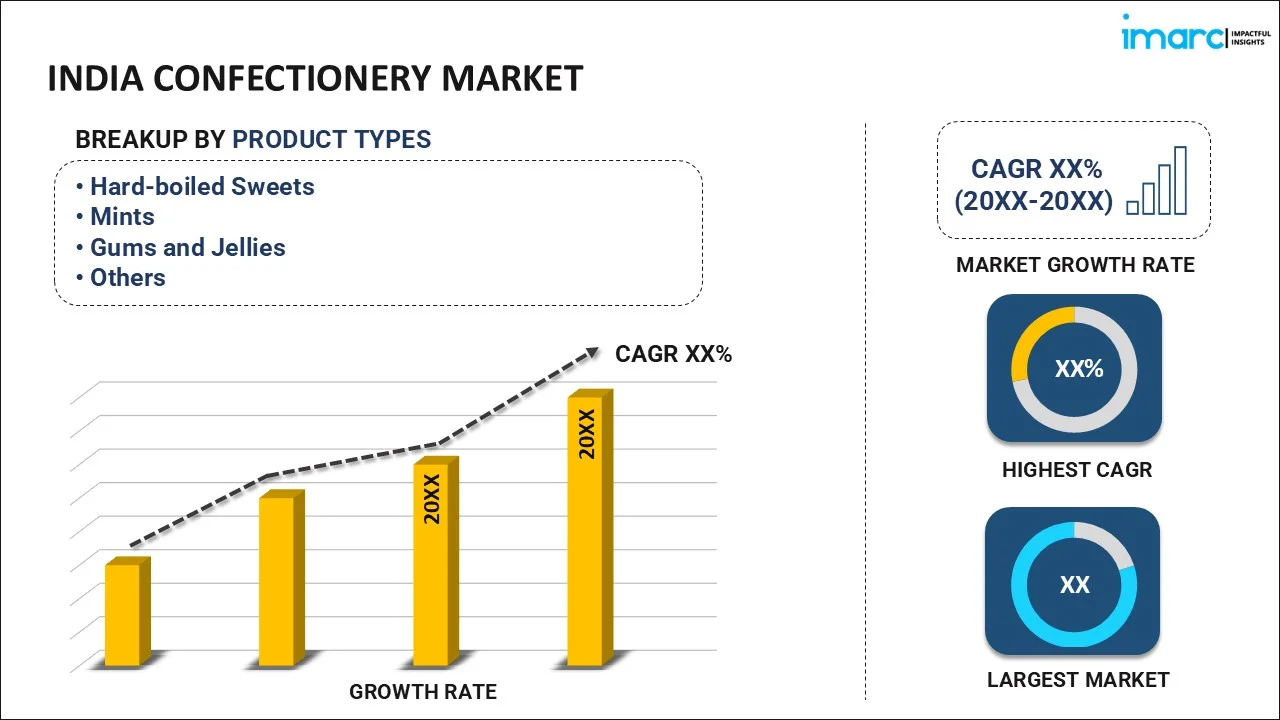
Report Attribute Key Statistics Base Year Forecast Years Historical Years Market Size in 2023 Market Forecast in 2032The India confectionery market size reached INR 359.5 Billion in 2023. Looking forward, IMARC Group expects the market to reach INR 576.5 Billion by 2032, exhibiting a growth rate (CAGR) of 5.39% during 2024-2032.
Confectionery refers to a wide range of food products that are rich in sugar and other sweeteners. They are prepared by using several ingredients, such as stabilizers, emulsifiers, gelling, flavoring, and thickening agents, which assist in enhancing the texture, taste, appearance, and elasticity of products. Confectionery items commonly include chocolates and non-chocolate candies, such as gum, ice cream, frozen desserts, sweet baked goods, etc. These products are widely available across supermarkets, online platforms, retail shops, bakery stores, hypermarkets, etc.
The emerging trend of gifting confectionery products, especially during festivals or special events such as birthdays, anniversaries, social meetings, etc., is primarily driving the Indian confectionery market. Additionally, the elevating levels of urbanization, improving consumer living standards, and increasing popularity of imported chocolates and candies, are some of the other key factors augmenting the sales of confectionery products in the country. Besides this, several key players are introducing limited-edition, premium confectionery products that are fortified with high-quality nuts, grains, and cereals. This, in confluence with the growing consumer per capita expenditures, are creating a positive outlook for the regional market. Moreover, the growing popularity of sugar-free confectioneries on account of the rising health concerns regarding cardiovascular diseases, obesity, diabetes, etc., is also propelling the product demand. Apart from this, the introduction of clean-label, cruelty-free, vegan, organic, and sustainably sourced confectionery products with no chemical additives and reduced allergens is further catalyzing the market growth. Numerous other factors, such as continuous advancements in ambient storage conditions and the advent of anti-microbial packaging solutions, are expected to drive the India confectionery market over the forecast period.
IMARC Group provides an analysis of the key trends in each sub-segment of the India confectionery market report, along with forecasts at the country and regional level from 2024-2032. Our report has categorized the market based on product type, age group, price point and distribution channel.
Breakup by Product Type:

Breakup by Age Group:
Breakup by Price Point:
Breakup by Distribution Channel:
Breakup by Region:
The competitive landscape of the industry has also been examined along with the profiles of the key players.
| Report Features | Details |
|---|---|
| Base Year of the Analysis | 2023 |
| Historical Period | 2018-2023 |
| Forecast Period | 2024-2032 |
| Units | INR Billion |
| Segment Coverage | Product Type, Age Group, Price Point, Distribution Channel, Region |
| Region Covered | North India, West and Central India, South India, East India |
| Customization Scope | 10% Free Customization |
| Report Price and Purchase Option | Single User License: US$ 2699 Five User License: US$ 3699 Corporate License: US$ 4699 |
| Post-Sale Analyst Support | 10-12 Weeks |
| Delivery Format | PDF and Excel through Email (We can also provide the editable version of the report in PPT/Word format on special request) |
We expect the India confectionery market to exhibit a CAGR of 5.39% during 2024-2032.
2. What are the key factors driving the India confectionery market?The introduction of limited-edition and premium confectionery products for gifting purpose, along with the advent of clean-label, cruelty-free, vegan, organic, and sustainably sourced confectionery products with no chemical additives and reduced allergens, is primarily driving the India confectionery market.
3. What has been the impact of COVID-19 on the India confectionery market?The sudden outbreak of the COVID-19 pandemic has led to the changing consumer inclination from conventional brick-and-mortar distribution channels towards online retail platforms for the purchase of confectionery-based food products.
4. What is the breakup of the India confectionery market based on the product type?Based on the product type, the India confectionery market has been segmented into hard-boiled sweets, mints, gums and jellies, chocolate, caramels and toffees, medicated confectionery, fine bakery wares, and others. Currently, chocolate holds the majority of the total market share.
5. What is the breakup of the India confectionery market based on the age group?Based on the age group, the India confectionery market can be divided into children, adult, and geriatric, where adult currently exhibits a clear dominance in the market.
6. What is the breakup of the India confectionery market based on price point?Based on the price point, the India confectionery market has been categorized into economy, mid-range, and luxury. Currently, economy accounts for the majority of the total market share.
7. What is the breakup of the India confectionery market based on the distribution channel?Based on the distribution channel, the India confectionery market can be segregated into supermarkets and hypermarkets, convenience stores, pharmaceutical and drug stores, online stores, and others. Among these, supermarkets and hypermarkets currently hold the largest market share.
8. What are the key regions in the India confectionery market?On a regional level, the market has been classified into North India, West and Central India, South India, and East India.